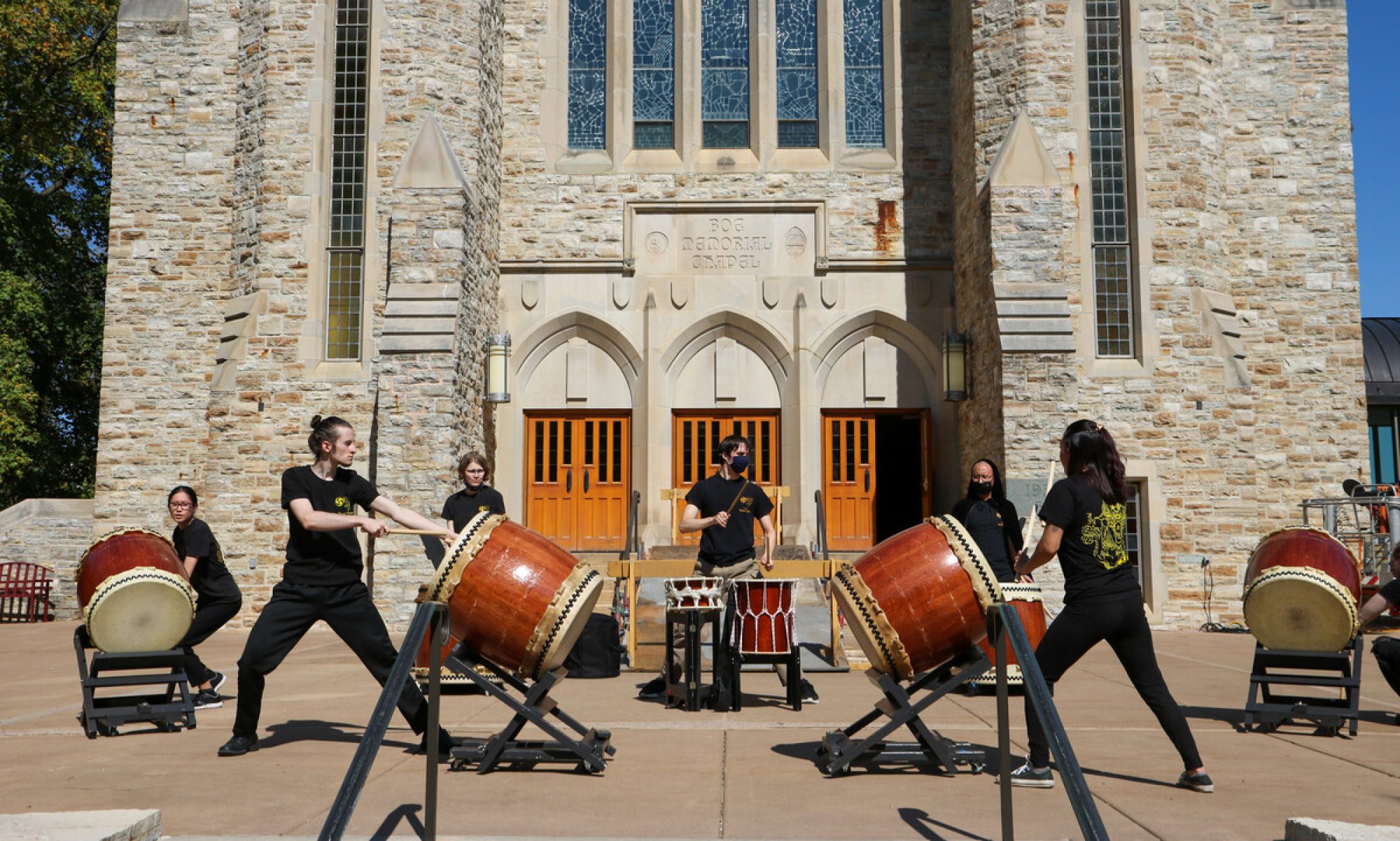Our Songs
Airbender 葉っぱになって – One of our four original “Bending” songs, Airbender is also known as Become a Leaf or Happa Ni Natte. It was composed by St. Olaf Taiko member Maxyne Leitner.
Bakuhatsu 爆発 – Composed by St. Olaf Taiko member Steven Geofrey. Meaning explosion, an upbeat and loud song our whole club can play at once.
Biscuits ビスケットと危険 – Composed by St. Olaf Taiko member Steven Geofrey. Also known as Biscuits and Danger or Bisuketto to Kiken, Biscuits involves many forms of back and forth playing between drums.
Earthbender 山道 – Composed by St. Olaf Taiko member Amanda Steimle. Earthbender is played with three chu-daiko players in the middle of the stage. It’s also known as Yamamichi.
Firebender 太陽の情熱 – Composed by St. Olaf Taiko member Maxyne Leitner. One of our “Bending” suite songs. Firebender is intense and complex and utilizes a lot of movements inspired by combat. It is also known as Taiyou no Jounetsu.
Jouba 乗馬 – Jouba was composed by former St. Olaf Taiko members Steven Geofrey and Scott Grandt and was inspired by the Legend of Zelda games.
Matsuri 祭り– Meaning Festival, Matsuri is a traditional taiko song we teach yearly to incoming kohai.
Omiyage お土産 – Originally taught to the club by Joe Mignano of Mu Daiko and written by Shoji Kameda. This song is typically played by senior members of the group as a goodbye song, and is quite difficult to learn. Omiyage means “gift”.
Ouichi – The Greatest, originally by the Taiko master Kenny Endo. Ouichi involves a lot of movement and is often one of the first songs taught to kohai members.
Raimei 雷鳴 – Meaning “Thunderstorm”, Raimei is a St. Olaf Taiko original song composed and choreographed by Oli Lew ’25. The song was written as a thank you gift to St. Olaf Taiko, and was directly inspired by St. Olaf Taiko songs Firebender and Waterbender. Raimei draws inspiration from big band jazz music, referencing the historical link between jazz music and Taiko in the United States. Keep an ear out to hear the different sections of the song combine, as, like a thunderstorm, this song requires multiple elements to truly be complete.
Raku 楽 – Originally by Shidara Taiko and taught to our club by Mu-Daiko, Raku has many versions unique to different groups. The name raku means “fun” and this song lives up to its name as a high-energy piece we all play together.
Ryū 龍の食事 – Formerly known as Ryū no Shokuji, or The Dragon’s Meal, this complex song tells the story of a dragon and has a serious and tense tone.
Waterbender 青波 – Written by St. Olaf Taiko member Rachel Lamb. Waterbender uses a unique and fluid style of movement as well as many dance elements. It is also known as Aonami.
Yuubinkyoku 郵便局への旅 – Composed by Steven Geofrey. Also known as Yuubinkyoku he no Tabi, or The Journey to the Post Office, this was the first original St. Olaf Taiko piece. It tells the story of a St. Olaf student who rushes to the Post Office before it closes so he can retrieve a cake from his mother. This song utilizes the fue, or flute. We often teach Yuubinkyoku as a first song to incoming kohai.
Lost and Retired Songs
Ayame – Iris, an original song composed by St. Olaf Taiko member Olivia James as a thank you to the club’s original teacher, Iris Shiraishi.
Densetsu – Legend
Ei Ja Nai Ka – Isn’t it Good? (colloquial), written by PJ Hirabayashi of San Jose Taiko, is a tribute to early Japanese immigrants and the hard labor they endured working on farms, in the mines, fishing, and on the railroad. It includes singing and dancing.
Hoshizora – Starry Sky by Josh Jackson
The Journey – This mysterious song only exists in the St. Olaf Taiko private archive of videos, as no known public recording of it exists. It was composed by a St. Olaf member early in the club’s history and notably complex. It was retired many years ago with the instructions left behind for it to never be played outside of the club, again.
Tatakai – The Fight, a song composed by former St. Olaf student, Maxwell Johnson, as an experiment to create a Taiko song in 7/8 timing.
The Dancing Bear of Dublin – also known as Odoru Kuma.
